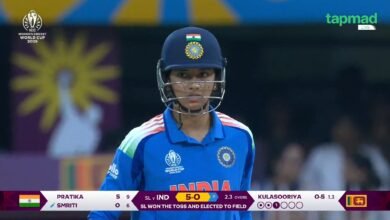
In a pulsating opening to their home ICC Women’s Cricket World Cup 2025 campaign, India secured a vital 59-run victory over co-hosts Sri Lanka, a result that tells a far more complex story than the comfortable margin suggests. At the Barsapara Cricket Stadium in Guwahati, a packed house witnessed a performance of startling duality: an Indian team that flirted with disaster, only to be salvaged by an extraordinary display of lower-order resilience. The match was a microcosm of India’s immense potential and its lingering frailties, showcasing a top order that crumbled under pressure and a tenacious, deep batting line-up that refused to surrender.
Put in to bat after Sri Lankan captain Chamari Athapaththu won the toss, India plunged into a catastrophic collapse, slumping to a precarious 124 for 6 in a match shortened to 47 overs per side by rain. With the tournament hosts staring down the barrel of an embarrassing curtain-raiser, all-rounder Deepti Sharma and the gritty Amanjot Kaur produced a partnership for the ages, steering their side not just to safety, but to a commanding total of 269 for 8. Sharma, who was later named Player of the Match, was the architect of the victory, her calm half-century under pressure complemented by a decisive bowling spell that broke the back of Sri Lanka’s chase. While the two points provide the perfect start, the nature of the win—forged in the crucible of a near-total collapse—serves as both a celebration of India’s fighting spirit and a stark warning of the top-order vulnerabilities they must address to realize their dream of a maiden World Cup title.
The Unraveling: Ranaweera’s Veteran Craft Exposes a Brittle Core
Chamari Athapaththu’s decision to field first on a fresh Guwahati pitch was immediately vindicated. The early breakthrough she sought came in the fourth over when the dangerous, in-form Smriti Mandhana, attempting to clear the off-side, sliced a delivery from Udeshika Prabodhani to a juggling Vishmi Gunaratne at deep cover for just 8 runs. This early setback forced India into a period of cautious consolidation. Openers Pratika Rawal and Harleen Deol navigated the powerplay but struggled to impose themselves against disciplined Sri Lankan bowling. Their partnership began to build, but at a glacial pace, with dot balls accounting for a staggering 68% of the deliveries in the initial stages.
The innings was further fragmented by a persistent drizzle that forced the players off the field for over an hour, ultimately truncating the contest to a 47-over affair. Upon resumption, Rawal and Deol brought up a 50-run stand, but the momentum remained elusive. The turning point arrived with the introduction of veteran left-arm spinner Inoka Ranaweera. She first broke the partnership by tempting Rawal into a mistimed shot to deep midwicket for 37, ending a 50-run stand that had consumed 82 balls. What followed was a masterclass in pressure bowling that ripped the heart out of India’s middle order. In a single, match-altering over—the 26th of the innings—Ranaweera produced a spell of bowling that left the home crowd in stunned silence. She first had Harleen Deol caught for a well-made 48, denying her a half-century. The very next ball, Jemimah Rodrigues was trapped for a golden duck. Two balls later, captain Harmanpreet Kaur was also dismissed, leaving India in absolute disarray at 121 for 5.
The collapse was not merely a product of exceptional bowling; it was amplified by what on-ground observers noted were “soft dismissals” on a pitch that was offering turn but was by no means unplayable. The abject nature of the collapse pointed towards a psychological fragility rather than a purely technical one. The procession was complete when Athapaththu herself joined the attack, dismissing Richa Ghosh for 2 and plunging India into the abyss at 124 for 6. Ranaweera, in her magnificent spell, became the second-oldest player to claim a four-wicket haul in Women’s ODIs, using her vast experience to exploit a brittle Indian core that seemed to buckle under the weight of home-World Cup expectation.
The Anatomy of a Collapse
| Wicket | Player Dismissed | Score | Over | Bowler |
| 3rd | Harleen Deol | 121/3 | 25.2 | Inoka Ranaweera |
| 4th | Jemimah Rodrigues | 121/4 | 25.3 | Inoka Ranaweera |
| 5th | Harmanpreet Kaur | 121/5 | 25.5 | Inoka Ranaweera |
| 6th | Richa Ghosh | 124/6 | 26.6 | Chamari Athapaththu |
Export to Sheets
The 103-Run Lifeline: How Grit, Luck, and Strategy Forged a Comeback
With India “flat on the mat” and their World Cup opener spiraling into a catastrophe, Deepti Sharma and Amanjot Kaur walked to the middle under immense pressure. What unfolded over the next 18 overs was not just a recovery; it was a statement of intent, a demonstration of the newfound depth and resilience that defines this Indian team. Their partnership, which would ultimately yield a match-defining 103 runs, was a masterclass in situational awareness, beginning with cautious consolidation before blossoming into a calculated counter-attack.
The duo weathered the storm created by Ranaweera and the other Sri Lankan spinners, focusing on rotating the strike and rebuilding the innings brick by brick. Their effort was significantly aided by a startlingly sloppy fielding performance from Sri Lanka, who seemed to lose their composure after gaining complete control. Amanjot Kaur, in particular, lived a charmed life, being dropped a staggering four times during her innings. Sri Lanka’s profligacy in the field proved to be the lifeline India desperately needed, and Kaur made them pay for every single error.
As the partnership grew, so did their confidence. Both batters reached richly deserved half-centuries. Amanjot, riding her luck, struck a gutsy 57 from 56 balls, while Deepti played the anchor role to perfection, compiling a calm, run-a-ball 53. Their century stand was the largest of the innings and completely reversed the game’s momentum, pulling India back from the brink of a sub-200 total and laying the foundation for a competitive score. This performance signaled a crucial evolution in India’s team structure. In previous years, the loss of the top order, including the captain, would have been a terminal blow. Here, the number seven and eight batters demonstrated not only the skill but the temperament to win a match from a seemingly hopeless position. This reflects a new brand of fearlessness, a departure from the historical over-reliance on the top three, and a testament to the rise of genuine all-rounders who thrive under pressure.
The Final Flourish: Sneh Rana’s Cameo Turns the Screw
The foundation laid by Deepti and Amanjot was transformed into an imposing fortress by a blistering late cameo from Sneh Rana. Walking in after the dismissal of Kaur, Rana launched an immediate and devastating assault on the tiring Sri Lankan bowlers, ensuring the momentum of the century partnership was not just maintained but accelerated. She smashed a vital, unbeaten 28 runs from a mere 15 deliveries, a whirlwind innings studded with two fours and two powerful sixes that sent the Guwahati crowd into a frenzy.
This final onslaught exposed a complete breakdown in Sri Lanka’s discipline. Having controlled the game for over 30 overs, their bowlers and fielders began to fray at the edges. The final two overs were particularly chaotic, leaking a costly 34 runs that pushed India’s total from competitive to psychologically daunting. The final over of the innings, bowled by Achini Kulasuriya, was a case in point. It began with Rana dispatching a length ball for a huge six over deep square leg. It later included four leg byes and a sloppy misfield at long on that gifted Rana another boundary, a moment of frustration that visibly angered captain Athapaththu.
While Deepti Sharma was caught at deep mid-wicket off the final ball of the innings, her job was done. The late surge, led by Rana, had propelled India to a final total of 269 for 8. This score seemed an impossible dream when they were reeling at 124 for 6. The late acceleration was a psychological weapon as much as a tactical one. It completely demoralized a Sri Lankan side that would have walked off the field “kicking themselves” for the dropped catches and the late collapse in discipline. They were left to contemplate not just a challenging revised target of 271, but the bitter reality that they had let a dominant position slip through their fingers.
The Chase: Athapaththu’s Lone Stand and Sharma’s Decisive Strike
Facing a revised DLS target of 271, Sri Lanka’s hopes rested heavily on the shoulders of their talismanic captain, Chamari Athapaththu. The chase began with intent, but India struck an early and important blow. Debutant Kranti Gaud produced a moment of magic, a perfect length delivery that crashed into the top of Hasini Perera’s (14) off-stump as she attempted an awkward cross-batted shot.
Despite the early loss, Athapaththu played with characteristic aggression. She took the attack to the Indian bowlers, hitting boundaries and a spectacular six over point to keep her team well in the hunt. Alongside Harshitha Samarawickrama, she forged a stabilizing partnership that began to cause some concern in the Indian camp. At 82 for 1, Sri Lanka were building a solid platform. However, the definitive moment of the second innings arrived, and fittingly, it was Deepti Sharma who delivered it. Having rescued India with the bat, she returned to break the game open with the ball, firing in a perfect yorker that comprehensively bowled Athapaththu for a brisk 43 off 47 balls.
The dismissal of their captain proved to be the fatal blow for Sri Lanka. As the required run rate climbed, the Indian spinners, led by Deepti and Sneh Rana, tightened their grip, choking the flow of runs and inducing errors. The Sri Lankan chase “faltered” as wickets began to fall at regular intervals. Nilakshi de Silva offered some resistance with a fighting 35, but it was a lone hand in a losing battle. The chase exposed a critical strategic weakness for Sri Lanka: an over-reliance on their singular match-winner. Unlike India, who had recovered from the failures of their senior players, Sri Lanka’s batting lineup lacked the depth and resilience to mount a challenge once Athapaththu was back in the pavilion. Pratika Rawal eventually trapped Inoka Ranaweera in front to end the innings, bowling Sri Lanka out for 211 in 45.4 overs and sealing a comprehensive victory for the hosts.
By the Numbers: A Statistical Breakdown of the Opener
The narrative of the match—a story of collapse, recovery, and all-round dominance—is clearly reflected in the final statistics. Deepti Sharma’s figures with both bat and ball underscore her Player of the Match performance, while Inoka Ranaweera’s four-wicket haul highlights the damage she inflicted on India’s top order.
Key Individual Performances
| Player Name (Team) | Batting Performance | Bowling Performance |
| Deepti Sharma (IND) | 53 runs (53 balls) | 2 wickets for 35 runs |
| Amanjot Kaur (IND) | 57 runs (56 balls) | 1 wicket for 21 runs |
| Sneh Rana (IND) | 28 runs (15 balls)* | 2 wickets for 29 runs |
| Inoka Ranaweera (SL) | 3 runs (3 balls) | 4 wickets for 46 runs |
| Chamari Athapaththu (SL) | 43 runs (47 balls) | 1 wicket for 25 runs |
| Harleen Deol (IND) | 48 runs (65 balls) | – |
| Pratika Rawal (IND) | 37 runs (59 balls) | 1 wicket for 3 runs |
Export to Sheets
Conclusion: “I Enjoy These Situations” – Sharma’s Mindset Sets Tone for India’s Campaign
In the end, the story of the World Cup opener was written by its undisputed hero, Deepti Sharma. Her all-round contribution was immense, but it was her post-match comments that provided the most telling insight into the mindset of this Indian team. “It was a turning point,” she said of the partnership with Amanjot. “No pressure at all because I am used to these types of innings and situations… I do not feel pressure, I enjoy my batting”.
This statement is more than just a post-match platitude; it is a declaration of a cultural shift. It signals the rise of the specialist all-rounder as a core pillar of the team’s identity—a player who thrives on, rather than fears, adversity. The calm execution under extreme duress by both Deepti and Amanjot was not a desperate scramble for survival; it was the confident fulfillment of a role by players mentally prepared for the challenge.
India walks away from their opening fixture with two crucial points and the momentum of a hard-fought victory. The win, however, carries a dual narrative. It exposed a worrying fragility in a star-studded top order that must find its footing on home soil. But it also unveiled a formidable lower-order strength, a fighting spirit embodied by players like Deepti, Amanjot, and Sneh Rana, who proved they can win matches from almost any position. This opening performance, defined by Deepti’s skill and her unflappable mindset, sets a complex but ultimately positive tone for India’s quest for World Cup glory. They have been tested, they have bent, but they have not broken.








